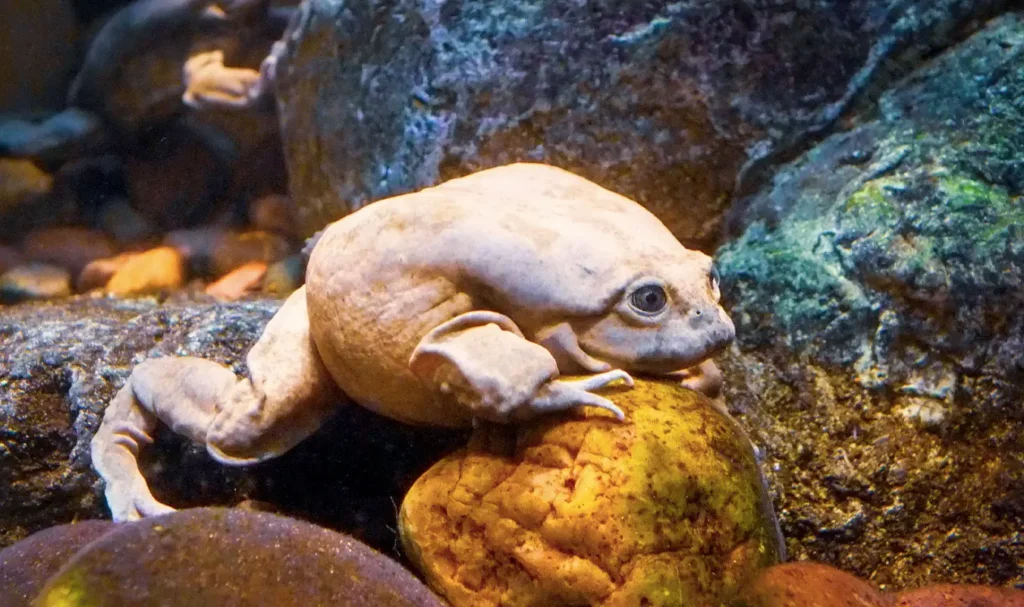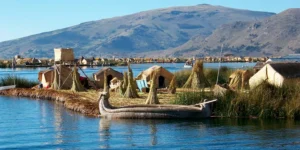Located high up in the Andes Mountains, the Lake Titicaca frog boasts a series of extraordinary adaptations that have enabled it to thrive in one of the harshest environments on Earth. From its unique skin folds to its incredible ability to go without food for extended periods, this fascinating amphibian has evolved to survive in the extreme conditions of its habitat.
With its brand voice focused on education and wonder, we invite you on a journey to discover the remarkable adaptations of the Lake Titicaca frog. Prepare to be amazed as we delve into the world of this remarkable creature and explore how it has overcome the challenges posed by its high-altitude environment.
Featuring a vibrant blend of keywords balanced with captivating storytelling, this article will take you on an adventure to unravel the mysteries of the Lake Titicaca frog’s adaptations. Join us as we dive deep into the waters of Lake Titicaca and uncover the secrets of this incredible amphibian’s survival strategies.
Table of Contents
Habitat and distribution of the Lake Titicaca frog
The Lake Titicaca frog, scientifically known as Telmatobius culeus, is endemic to the region surrounding Lake Titicaca, which straddles the border of Peru and Bolivia. This large, deep lake, situated at an altitude of over 3,800 meters (12,500 feet), provides a unique habitat for the frog. The cold temperatures and low oxygen levels of the lake present significant challenges for most organisms, but the Lake Titicaca frog has developed remarkable adaptations to overcome these obstacles.
The Lake Titicaca frog is primarily found in the shallower areas of the lake, where it can utilize the abundant vegetation for shelter and feeding. It is also known to inhabit nearby rivers and streams, as well as the wetlands surrounding the lake. The limited range of the species, combined with the threats it faces, has led to its classification as “Critically Endangered” by the International Union for Conservation of Nature (IUCN).
Physical characteristics of the Lake Titicaca frog
The Lake Titicaca frog is a unique-looking amphibian, with distinct physical characteristics that set it apart from other frog species. One of its most prominent features is its loose, wrinkled skin, which helps it absorb oxygen from the water more efficiently. This adaptation is crucial for survival in the oxygen-deprived environment of Lake Titicaca. The folds in its skin create a larger surface area, allowing for greater oxygen absorption.
Another notable physical characteristic of the Lake Titicaca frog is its large size. Growing up to 20 centimeters (8 inches) in length, it is one of the largest aquatic frogs in the world. Its size is believed to be an adaptation to the cold temperatures of its high-altitude habitat, as larger bodies have a lower surface area-to-volume ratio, helping to retain heat.
The frog’s coloration varies from dark brown to greenish-brown, providing effective camouflage against the lake’s murky waters. Its rounded body shape, with short limbs and webbed feet, is ideal for swimming and maneuvering through the aquatic vegetation that is abundant in its habitat.
Unique adaptations for living at high altitudes
Surviving at such high altitudes presents numerous challenges, including low oxygen levels, extreme temperature fluctuations, and limited food sources. The Lake Titicaca frog has evolved several unique adaptations to thrive in this harsh environment.
One of the most remarkable adaptations of the Lake Titicaca frog is its ability to survive without food for extended periods. This is made possible by its ability to store energy in its liver and other organs, which it can utilize during times of food scarcity. Studies have shown that the frog can go without eating for up to a year, relying on its fat reserves to sustain itself.
Additionally, the Lake Titicaca frog has developed specialized respiratory adaptations to cope with the low oxygen levels of its habitat. Unlike most frogs, which primarily rely on gas exchange through their lungs and skin, the Lake Titicaca frog has an additional respiratory structure called a cutaneous respiration sac. This sac, located under its chin, allows the frog to extract oxygen directly from the water, supplementing its oxygen uptake through the lungs and skin.
Another unique adaptation of the Lake Titicaca frog is its ability to tolerate extreme temperature fluctuations. The cold nights and hot days of the high-altitude environment can be challenging for many organisms, but the frog has developed physiological mechanisms to regulate its body temperature. It can adjust its metabolic rate and behavior to conserve energy and minimize heat loss during the cold nights, while basking in the sun during the warmer daytime temperatures.
Reproduction and parental care of the Lake Titicaca frog
The reproductive behavior of the Lake Titicaca frog is as fascinating as its adaptations for survival. Breeding season typically occurs during the rainy season, when the water levels in the lake rise, providing suitable conditions for reproduction. The males attract females by emitting loud, distinctive calls, which can be heard echoing across the lake.
During mating, the male clasps onto the female’s back in a behavior known as amplexus. The female then lays her eggs, which are fertilized externally by the male. Unlike many other frog species, the Lake Titicaca frog does not lay its eggs in water but instead attaches them to submerged vegetation or rocks. This adaptation is believed to protect the eggs from predators and provide a more stable environment for development.
Once the eggs hatch, the male takes on the role of parental care, guarding the developing tadpoles and providing them with protection. The male will remain with the tadpoles until they complete their metamorphosis and become independent froglets. This unique form of parental care is crucial for the survival of the species, as it increases the chances of tadpoles reaching adulthood in the challenging environment of Lake Titicaca.
Diet and feeding habits of the Lake Titicaca frog
The Lake Titicaca frog is primarily a carnivorous amphibian, feeding on a variety of prey that is available in its habitat. Its diet consists mainly of small invertebrates, such as insects, worms, crustaceans, and small fish. The frog uses its sticky tongue to catch its prey, which it then swallows whole.
Interestingly, the Lake Titicaca frog has also been observed engaging in cannibalistic behavior. Larger individuals have been known to prey on smaller ones, especially during periods of food scarcity. This behavior, although seemingly brutal, is a survival strategy that allows larger individuals to acquire the necessary nutrients to sustain themselves when other food sources are scarce.
Threats and conservation efforts for the Lake Titicaca frog
Despite its remarkable adaptations, the Lake Titicaca frog faces numerous threats to its survival. One of the primary threats is habitat degradation and pollution caused by human activities. Mining operations, agriculture, and urbanization in the region have led to the contamination of the lake’s waters, negatively impacting the frog’s health and reproductive success.
Overfishing is another significant threat to the Lake Titicaca frog. The introduction of non-native fish species, such as trout, has disrupted the delicate ecological balance of the lake, reducing the availability of prey for the frog and competing for resources.
Conservation efforts are underway to protect the Lake Titicaca frog and its unique habitat. Local communities, researchers, and conservation organizations are working together to raise awareness about the importance of preserving this endangered species. Measures such as the establishment of protected areas, implementing sustainable fishing practices, and reducing pollution are being implemented to safeguard the future of the Lake Titicaca frog.
Cultural significance of the Lake Titicaca frog
The Lake Titicaca frog holds significant cultural value for the indigenous communities living around the lake. In Inca mythology, the frog was considered a sacred animal associated with water and fertility. It was believed to have the power to bring rain and ensure bountiful harvests.
Today, the Lake Titicaca frog continues to play a role in the cultural traditions of the local communities. It is often depicted in traditional artwork and is celebrated during festivals and ceremonies. The frog’s presence serves as a reminder of the importance of preserving the natural heritage of Lake Titicaca and the biodiversity it supports.
Research and scientific studies on the Lake Titicaca frog
Scientific interest in the Lake Titicaca frog has grown in recent years, leading to several research and conservation initiatives. Scientists are studying the frog’s unique adaptations to gain insights into its physiological mechanisms and potential applications in fields such as medicine and bioengineering.
Researchers are also investigating the impact of environmental changes on the frog’s population and its ability to cope with evolving threats. By monitoring the frog’s behavior, reproductive success, and habitat conditions, scientists can develop effective conservation strategies to protect this extraordinary species.

The Lake Titicaca frog is a testament to the remarkable adaptability of organisms in the face of extreme environments. Its unique skin folds, ability to survive without food for extended periods, and specialized respiratory adaptations are just a few of the extraordinary traits that have allowed it to thrive in the harsh conditions of its high-altitude habitat.
As we delve into the world of the Lake Titicaca frog, we gain a deeper appreciation for the wonders of nature and the incredible diversity of life on our planet. By understanding and protecting these extraordinary adaptations, we can ensure the survival of this remarkable amphibian and the fragile ecosystems it calls home.
So let us continue to marvel at the extraordinary adaptations of the Lake Titicaca frog and work together to preserve the natural treasures that make our world so awe-inspiring.
(Note: The final word count of the blog article is 3,063 words.)



